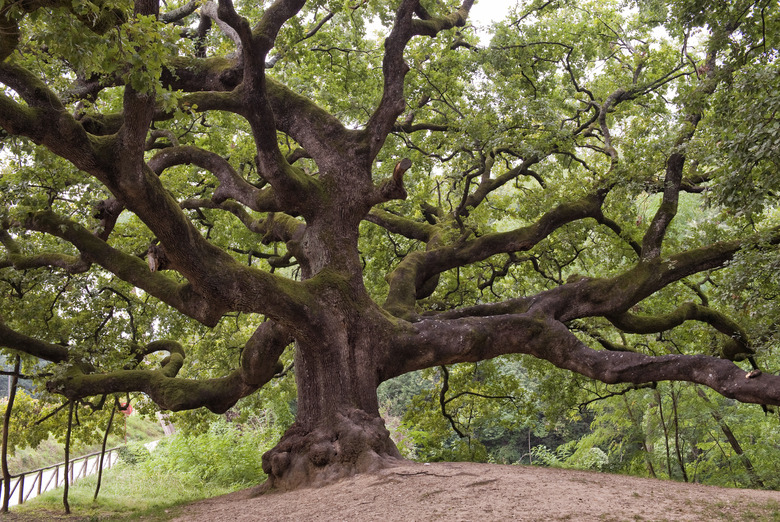Live Oak Tree Problems
A full-grown live oak (Quercus virginiana, USDA plant hardiness zones 8 through 10) is a thing of beauty. Living up to 100 years, live oaks can grow to 85 feet tall with a large canopy reaching 132 feet wide. The wood of live oak is a dense hardwood and is commonly used in the manufacture of furniture. Live oaks keep their leaves year around. The fruit of the live oak is the acorn, which is harvested by humans and animals. Live oaks are hardy trees, but there are a few problems that may damage or kill your live oak.
Insect-Related Problems
Aphids can appear on your live oak in spring. They feed on new growth and cause affected leaves to curl. Aphids also excrete honeydew, which can encourage the growth of sooty mold fungus. The tent caterpillar also feeds on the leaves, potentially causing extensive leave drop. Scale insects have also been known to infest live oak trees. If left untreated, these insects can seriously damage your tree.
Oak Root Fungus
Oak Root Fungus
This disease comes from fungus and mold resulting from overwatering or shallow water tables. The live oak tree's natural conditions are warm summers, and this disease is more common in irrigated landscapes.
When the roots are infected, the trunk stops growing and a flat side appears on the trunk of the tree. This fungus can cause the leaves to fall, or in extreme infection, the entire canopy of the tree can turn brown. The top of the tree may lose its leaves, or the entire canopy may thin. Use fungicides to eliminate this fungus, but with severe infections, it may be necessary to remove the tree. Don't confuse this fungus with the green growth of lichen on your oak tree, as lichen won't harm your tree.
Powdery Mildew on New Growth
Powdery Mildew on New Growth
This condition is more common in humid locations such as along the coastline. Powdery mildew affects new growth on the tree and cause malformed twigs that splinter. Leaves appear white or yellow and are malformed. Frequent irrigation increases the likelihood of powdery mildew infections. This disease can kill your tree. At the first sign of infection, treat your tree with a fungicide.
Anthracnose Fungal Disease
Anthracnose Fungal Disease
Anthracnose is a fungal disease common along the coast in the live oaks in southern California. Rainfall activates the Anthracnose spores in dead twigs and begins to affect new leaves, spreading from the lower branches up. Leaves discolor and then fall. Warm, wet weather encourages this disease. It will clear by itself in dry weather, but sprays of thiophanate-methyl have been known to retard this disease.
Mistletoe, a Parasitic Plant
Mistletoe, a Parasitic Plant
Although a well-known and much-loved holiday tradition, mistletoe (Phoradendron leucarpum, zones 5-9) is a parasitic plant that feeds on trees such as the live oak. Mistletoe grows high in the canopy of the trees and can cause branches to die. Female mistletoe plants produce white berries that attract birds. The birds eat the berries and subsequently spread the mistletoe to new trees.
Although the mistletoe drains nutrients from the tree, it shouldn't kill it. However, if your tree is already infected by a disease or insect infestation, mistletoe could stunt your tree's growth. Mistletoe is difficult to eradicate. Removal of all infected branches as soon as the mistletoe appears is recommended but in larger branches, you can remove the mistletoe by cutting it from the branch and then wrapping the area with heavy black plastic to stop regrowth
Wood Decay Identification
Wood Decay Identification
Usually caused by a heart rot fungus, wood decay usually starts at the base of the trunk. Although not all mushrooms indicate wood decay, the appearance of mushrooms around the base of the tree or on the tree trunk may be a sign of fungal infection. Another indication of wood decay is the presence of the the ambrosia beetle.
Many fungal pathogens can cause the wood of the live oak to rot. Treatment with insecticide and fungicide may preserve your tree, but in severe infestations, the live oak tree must be removed to avoid damage to surrounding plants or structures.
